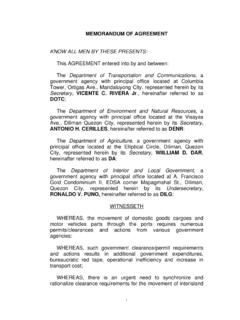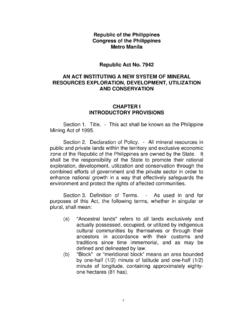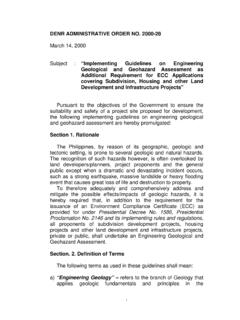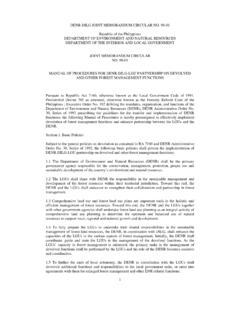Transcription of DENR ADMINISTRATIVE ORDER NO. 2000-98 SUBJECT : Mine ...
1 DENR ADMINISTRATIVE ORDER NO. 2000-98 . SUBJECT : Mine Safety and Health Standards AUTHORITY FOR THE PROMULGATION OF THIS STANDARD. Pursuant Section 8 of Republic Act No. 7942, otherwise known as the Philippine Mining Act of 1995 and the pertinent provisions of Chapter 15 of DENR ADMINISTRATIVE ORDER No. 96-40, as amended and Book IV Rule II Section 1(c) of the Implementing Rules and Regulations of the Labor Code of the Philippines, as amended, to implement the functions of the Director of Mines &. Geosciences with regards to mine safety under Section 3 (c) of Commonwealth Act No. 136, the following health, sanitation and safety standards are hereby promulgated. OBJECTIVES. This ORDER is promulgated for the purpose of.
2 1. To promote a culture of safety and health;. 2. To provide for the strict enforcement of safety and health measures;. 3. To provide for effective monitoring systems, inspections, investigations and inquiries to improve health and safety;. 4. To establish tripartite linkages in promoting safety and health matters;. 5. To promote training and human resources development;. 6. To comply with the international law obligations of the government relating to mine safety and health. SCOPE AND COVERAGE. This ORDER shall govern all employers, employees, contractors, permittees, service contractors and other entities engaged in any exploration, mining, quarrying, mineral processing, other allied or related operations. 1. TITLE AND DEFINITIONS.
3 TITLE : This ORDER shall be known and may be cited as the Mine Safety and Health Standard . DEFINITION OF TERMS : As used in, and for the purpose of this ORDER , the following terms, whether in the singular or plural form, unless the context indicates otherwise shall have the following meaning: 1. ORDER the Mine Safety and Health Standards;. 2. Bureau the Mines and Geosciences Bureau;. 3. Director the Director of Mines and Geosciences Bureau;. 4. Accident an undesired event in which, the contact, the exposure or the movement of a person to objects, equipment, machineries, substances, conditions or other persons may or may not cause personal injury, damage to properly and delay. 5. Accident Frequency Rate the total fatal and non-fatal lost-time accidents per million manhours worked, and may be expressed in the following formula: No.
4 Of Lost-Time Accident Frequency Rate = x 1,000,000_____. Manhours Worked 6. Accident Severity Rate the days lost per million manhours worked and may be expressed in the following formula: Severity Rate = No. of Days Lost x 1,000,000. Manhours Worked 7. Authorized Nuclear Device Operators inducted, trained and qualified to use and operate the nuclear device as defined under the code of Philippine Nuclear Research Institute (PNRI) Regulations 2. 8. Blaster a person who is a holder of a valid Blaster's Foreman license issued by the Philippine National Police upon the proper endorsement of the Bureau. 8. Blasting Area the area where actual blasting operations will be conducted including the vicinity in which concussions and/or flying material can be reasonably be expected to cause injury or property damage.
5 9. Contractor a perfected mining rights holder. 10. Decommissioning a process in which the mine facility is placed in a safe and environmentally acceptable condition prior to cessation of mining operation. 11. Detonator device used for detonating an explosive;. like ordinary, electric, non-electric blasting caps, exploders, percussion caps, primers, electric detonators. 12. Dose Limits amount of exposure to radiation in excess of As Low As Reasonably Achievable (ALARA) or CPR Part 3 limits. 13. Dredge any floating vessel used for mining operations consisting of digging, cutting, excavating or raising (whether by mechanical, hydraulic or pneumatic means) any rock, metal, mineral or mineral substance including sand and gravel from below the surface of a body of water and the purpose of treating or otherwise dealing with any rock and minerals which have been dug, cut, excavated or raised above water.
6 14. Electrical Installations include but not limited to electrical supply equipment, electrical utilization equipment, electric generating plant, electric supply line and substation. 15. Electrical Supply Equipment any equipment which produces, modifies, regulates controls or safeguards the supply of electric energy. 16. Employee any person hired, permitted or suffered to work by an employer. 3. 17. Employer includes any person or entity acting directly or indirectly in the interest of an employer, in relation to an employee. 18. Excavation or Workings any or all parts of an active or inactive mine including shafts, tunnels, drifts, crosscuts and raises. 19. Explosive any chemical compound or mechanical mixture, which by fire, friction, concussions, percussion or detonation, may cause a sudden release of gases having pressure capable of producing destructive effects.
7 20. Hot Material a material having temperature exceeding 57 C. 21. Inhabited Building A building regularly occupied in whole or in part as a habitation for human beings, or any workplace, church, schoolhouse, railroad station, stores or other structures where people are accustomed to assemble, except any building or structure occupied in connection with the manufacture, transportation, storage or use of explosives. 22. Imminent Danger a condition or practice that could reasonably be expected to cause death or serious physical injury or damage to property prior to the adoption of appropriate measures to counter the risk. 23. Leaching process of dissolving the valuable minerals from an ore or concentrate feed and extracting the metal(s).
8 Of interest into the solution. 24. Leachants chemicals/reagents used in dissolving minerals/metals. 25. Liquefied Petroleum Gas the gas liquefied by compression consisting of flammable hydro-carbons, such as propane, butane, obtained as a by product from refining petroleum or from natural gas; used chiefly as domestic fuel;. industrial and motor fuel). 26. 4. 27. Lost-Time Accident those that will prevent the injured from reporting to work on the working day following the day of injury and thereafter. Also to be considered as lost-time accident is when the injured person, after reporting to work on the working day following the day of injury, fails to continue his normal work due to complications and accident resulting to permanent injuries or disabilities as listed in Appendix A.
9 Counting of days lost shall start from the time the injured person fails to report for work. 28. Lost-Time Accident, Fatal lost time accident that results in the death of the injured person. 29. Lost-Time Accident, Non-Fatal any injury which does not result in death or permanent total or permanent partial disability but which results in disability from work for a day or more. 30. Magazine any building or structure other than explosive manufacturing building used for the storage of explosives and blasting accessories. There are three (3). types of magazines. a. The Permanent Storage Magazine where a large quantity of explosive is kept. b. The Issuing Magazine where a small or moderate quantity of explosive is kept. c.
10 Portable Magazine an approved steel container used to store explosives for a short period of time. 31. Manager the person responsible for the overall direction, control and supervision of the entire operation. 32. Material Safety Data Sheet (MSDS) The Document that describes the identity of a substance which includes among others company product information, composition information on ingredients, hazard identification and control and clean-up procedures in cases of accidental spill. 33. Mechanical Equipment, Machinery or Process . steam engines, internal combustion engines, boilers, turbines, crushers, mills, mixers, pumps, compressors, cranes, conveyors, hoists, elevators, pipe lines, line-shifting 5. or the like, but shall not include motor vehicles, street cars, locomotives, steamships, motor ships, airplanes and similar machinery used as means of transportation.





